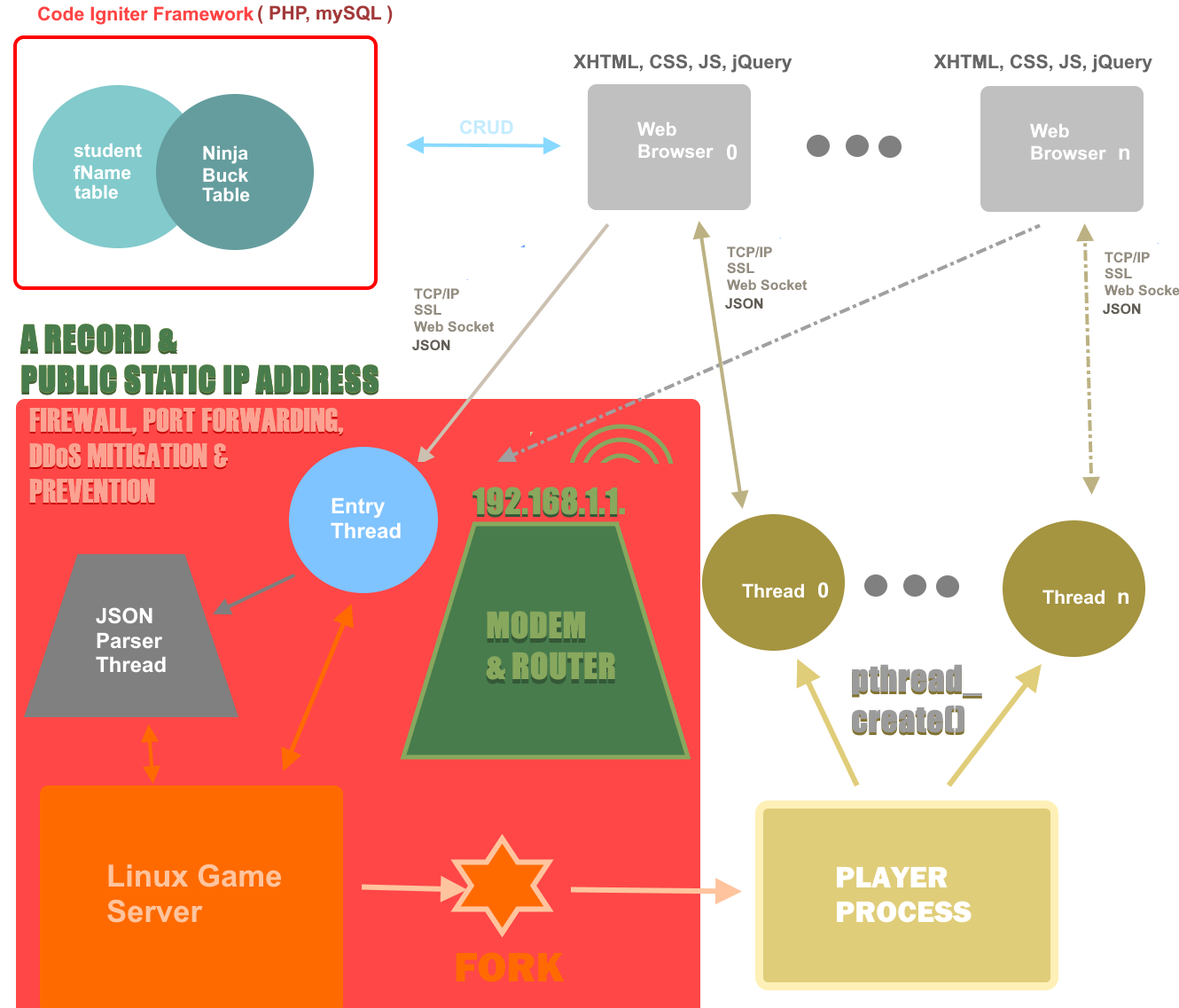|
Copyright © Vuong Duc Nguyen 2016 |
Welcome to my profile page. Thank you for visiting. Hover the mouse cursor over to an image or a video and more information will slide up. There is one large video in the middle that will take time to load and then will auto play.
I graduated from CSULB with a BS and MS in computer engineering. Topics that are explored on this website are 1. cloud and distributed computing, 2. client-server programming, 3. embedded system & robotics, 4. tree structure computation
| Demo | Architecture | Files & Link |
|---|
|
Click on the red, rounded bubble for more information.
|

1.Signaling server manages threads and establishes rules for communication using shared memory and synchronization using semaphore. SSL encryption, firewall rules, and Ubuntu built-in UFW prevented DDoS from bot nets. 2.Multi-threaded + Real Time using timers and events to update state of virtual entities, which results in a consistent state among all computing nodes. 3.State storage PHP and mySql saves context of threads to allow resumption of computation at a later time line. 4.BSD Socket, SSL, Web Socket, JSON serves as network interface for discovering peers and encrypted, serial communication across multiple, diverse networks. 5. HTML 5 canvas served as HMI between the signaling server and other distributed and peers. |
Click on the red, rounded bubble for more information. |
| Description | Architecture | Files & Link |
|---|
|
Click on the red, rounded bubble for more information.
|

1.Secured connection using SSL certificate. An upgrade handshake will allow HTTPS to be converted to the Web Socket Protocol. 2.Multi-threaded + Real Time using timers and events to update state of virtual entities, which results in a consistent state among all computing nodes. 3.State storage PHP and mySql saves context of threads to allow resumption of computation at a later time line. 4.BSD Socket, SSL, Web Socket, JSON serves as network interface for discovering peers and encrypted, serial communication across multiple, diverse networks. 5. HTML 5 canvas served as HMI between the signaling server and other distributed and peers. |
Click on the red, rounded bubble for more information. |
| Description | Architecture | Files & Link |
|---|
|
Click on the red, rounded bubble for more information.
|

1.Secured connection using SSL certificate. An upgrade handshake will allow HTTPS to be converted to the Web Socket Protocol. 2.Multi-threaded + Real Time using timers and events to update state of virtual entities, which results in a consistent state among all computing nodes. 3.State storage PHP and mySql saves context of threads to allow resumption of computation at a later time line. 4.BSD Socket, SSL, Web Socket, JSON serves as network interface for discovering peers and encrypted, serial communication across multiple, diverse networks. 5. HTML 5 canvas served as HMI between the signaling server and other distributed and peers. |
Click on the red, rounded bubble for more information. |
| Demo | Architecture | Files & Link |
|---|
|
Click on the red, rounded bubble for more information.
|

1.Signaling server manages threads and establishes rules for communication using shared memory and synchronization using semaphore. SSL encryption, firewall rules, and Ubuntu built-in UFW prevented DDoS from bot nets. 2.Multi-threaded + Real Time using timers and events to update state of virtual entities, which results in a consistent state among all computing nodes. 3.State storage PHP and mySql saves context of threads to allow resumption of computation at a later time line. 4.BSD Socket, SSL, Web Socket, JSON serves as network interface for discovering peers and encrypted, serial communication across multiple, diverse networks. 5. HTML 5 canvas served as HMI between the signaling server and other distributed and peers. |
Click on the red, rounded bubble for more information. |
| Demo | Architecture | Files & Link |
|---|
|
Click on the red, rounded bubble for more information.
|

1.Signaling server manages threads and establishes rules for communication using shared memory and synchronization using semaphore. SSL encryption, firewall rules, and Ubuntu built-in UFW prevented DDoS from bot nets. 2.Multi-threaded + Real Time using timers and events to update state of virtual entities, which results in a consistent state among all computing nodes. 3.State storage PHP and mySql saves context of threads to allow resumption of computation at a later time line. 4.BSD Socket, SSL, Web Socket, JSON serves as network interface for discovering peers and encrypted, serial communication across multiple, diverse networks. 5. HTML 5 canvas served as HMI between the signaling server and other distributed and peers. |
Click on the red, rounded bubble for more information. |
| Demo | Architecture | Files & Link |
|---|
|
Click on the red, rounded bubble for more information.
|

1.Signaling server manages threads and establishes rules for communication using shared memory and synchronization using semaphore. SSL encryption, firewall rules, and Ubuntu built-in UFW prevented DDoS from bot nets. 2.Multi-threaded + Real Time using timers and events to update state of virtual entities, which results in a consistent state among all computing nodes. 3.State storage PHP and mySql saves context of threads to allow resumption of computation at a later time line. 4.BSD Socket, SSL, Web Socket, JSON serves as network interface for discovering peers and encrypted, serial communication across multiple, diverse networks. 5. HTML 5 canvas served as HMI between the signaling server and other distributed and peers. |
Click on the red, rounded bubble for more information. |